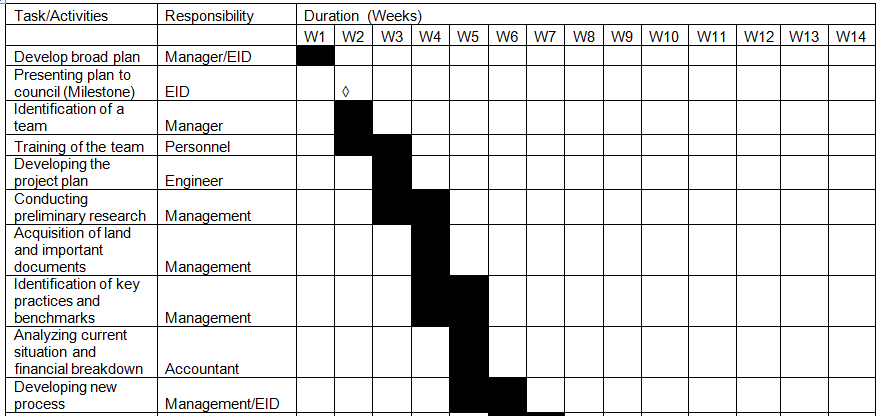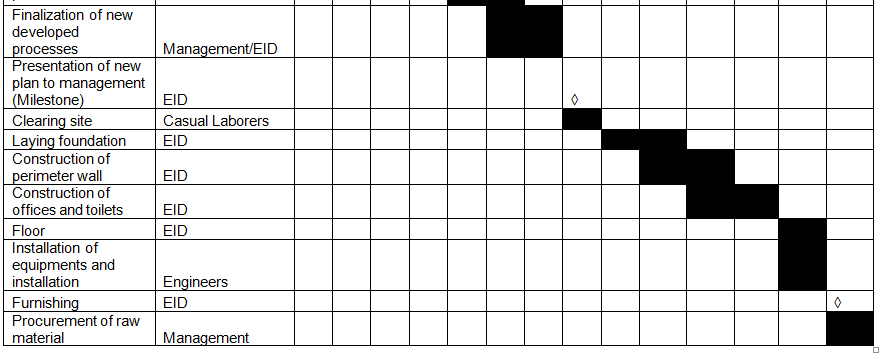Introduction
Project planning and management is one of the key processes which guarantees development and achievement of desired goals within companies. Conceptualization of the project is done with intentions of improving the level of output within the targeted areas.
One of the sole reasons for improving the production level is for the purposes of meeting the ever increasing market demand for wood products. It is important that the planning process incorporate future expansion and development of the designed project. It is the responsibility of the project manager to ensure that the project delivers with respect to the provided plan.
The project undergoes thorough check-up and assessment by relevant authorities including project manager as well as contracted auditors. The plan would provide summary of the intended monthly spending on budgetary allocations and project scope till the completion of the project. The budget would give possible financial break down on each phase enabling early financial adjustments (Adair and Bruce, 1994).
The project is about designing and building a wood workshop capable of producing quality modern furniture. The project fits into project management since it involves a lot of activity and financial planning. The construction work has to be scheduled over a period of time and every responsibility allocated appropriately.
Finances would be the greatest limitation on the project, considering the losses involved during material procurement and construction process due to changing economic times. Time management would also present one of the limitations owing to effects of the weather which at times might stop construction work for a while i.e. heavy downpour.


Project ScopeNB: The diamond presents milestone events; the rest presents tasks and activities over a period of time.
The project involves setting up and constructing Aloe Wood workshop (AWW) capable of supplying high quality, affordable furniture for the middle level income customers within the market (Beck, 2000).
The workshop is endowed to design and produce classic household furniture in large quantity and supplying to local companies, individuals and government offices and would as well target corporate customers within the market in the near future.
Conceptualization
The project would be started based on wide consultations on the best contractors and comparing their overall costs of construction. This would be done alongside determining the suitability of each section of the workshop and prioritizing on the construction process as well as purchase of equipments.
Each process will be discussed in details and every individual assigned their specified work areas in accordance to their level of qualifications. Cconceptualisation of the task involves developing the initial goal as well as technical specifications (Johnson et al, 1995).
The process should as well include the idea on building loyal and integral staff capable of doing recommendable work; this would involve hiring a part-time Accountant capable of managing the finances using computerized accounting software and manual paper-based system.
The work of the accountant would be creation of manual procedures capable of satisfying internal controls. AWW would then draft an administrative manual outlining the duties and service conditions for all employees, safety working policies when using the equipments, travel and Insurance policies as well as rules guarding the use of the company’s properties (King, 1992).
Designing
The main construction work will be divided into levels starting from, site clearing, laying the foundation for the purposes of eliminating and minimizing risks elements. This would help the managers and the contractors to easily understand the specified order of work to be done. Furnishings will be done in the last stages after completion of construction work (Kerzner, 1995).
Funding
The project would be funded by loan from the bank as well as the contribution from the owners in accordance to the stated financial plan. AWW would contribute assets which include land, buildings and wood working experts.
The contractor endowed with the responsibility of finishing the project being Expert Industrial Developers (EID). The goal of the project is to satisfy consumers’ desire for quality furniture products with the capability of lasting longer (Kerzner, 1995).
Project Evaluation
The work shop would be required to improve on its financial management skills by keeping clear financial records which incorporates monthly income, balance sheet and financial statements on a quarterly basis.
Recommended financial controls, policies as well as accounting procedures should be adhered to, since this would provide basis for financial and management decisions required for improvement in company performance. The work shop will be certified by the authorities in terms of meeting occupational safety inspection requirements (King, 1992).
The acquisition process is also important in this project, whereby the workshop will be developed on legally acquired land besides installation of modern computerized automated machines. Such machines always prove crucial in the process of reducing on the production and delivery time making goods available to consumers at appropriate times.
This would ensure that the production on special products is maximized reducing the cost of production to manageable level (King, 1992).
Land would be acquired at affordable prize and the necessary documents legalized by the approving authorities i.e. government. The total amount of money to be committed to this project would amount to $ 10 million for all the proposed work expected to run for three months.
The contractor involved in the planning would be Expert Industrial Developers known for their prominence in Industrial estate development as well as reasonable total project costs. The contactor would work on the basis of reimbursable contract. The construction would incorporate all engineering work, material procurement, building construction and commissioning.
The construction would start by site clearing which would last for three days, then followed by pouring out of the perimeter foundation which would take further three days. This would be followed by the erection of the walls and making of the floor.
The specifications given on the plan regarding the whole process determines the quality of equipments used the level of workmanship and overall performance. AWW will then procure installation of woodworking equipments and machineries.
The plan would reveal clear responsibilities for each individual staff in accordance to their areas of expertise. Skilled and experienced individuals knowledgeable in real concepts and project life cycle would be involved in the process of making decisions based on design. This enables appropriation in time utilization where the normal duration would be reduced before plan approval (Bennatan, 1995).
In procurement process, the workshop would import raw materials i.e. hardwood and softwood. This would enable production of excellent designs of furniture. Recruitment process would involve identifying and selecting qualified personnel with the capability of building integrity in the work place within the shortest time possible.
The management team including the director of the company would be outsourced to enable delivering quality goods to international standards. Other people to be involved in the process are Expert Industrial Developers capable of producing detailed specifications, schematics and plans for the purpose of quality buildings within the company.
Production manager would be engaged in the decision making for the reasons of understanding requirements for quality production. Budget preparation should be geared towards fulfilling the purposes of ascertaining on true figures required.
The budget preparation would be based on available finances and the projected profit estimates. The financial control will be left on the control of the Accountant and administration, keeping records on every financial transaction (Bennatan, 1995).
Alternatives
In case of arising alternatives, the workshop will prefer to maximize the available space instead of getting involved in lots of movement. The level of output would be increased through utilizing the use of modern technology which guarantees high production at lower cost.
There will be building of offices for the use by various departmental heads; all these should be narrowed down to financial ability of the owner without including any extra borrowing. However, financial planning should be used as a control tool helping in manageable subdivision of the project sections. Such process tends to be of much assistance before commencement of the project and during working processes (Kendall and Julie, 1995).
Conclusion
Success of the Project would be based on the time of completion of each and every activity within the plan. All the scheduled activities and time within the plan should be adhered to. The manager would be expected to understand every bit of the project to ensure right progression within the defined scope of activities. The overall plan produced rightfully projects the success of the project at completion.
The plan has got clear indication on the amount of finances required, the duration of time to be taken by each activity and the kinds of materials required. The management through guidance by the plan indicates the protocol to be followed when undertaking any process, as well as all the approving authorities (Expert Project Management, 2000, pp 1-14).
Recommendation
In the project planning processes much attention should be given the elements presenting parts of major works to be undertaken. Such elements should be granted priority within the already drafted budget through development of implementation hierarchy. There is as well the crucial aspect of understanding and following the order provided with the focus on the project objectives.
The scope of the project should be addressed under the following divisional components; Management, development of the foundation, contractor requirements and responsibilities, buying of equipment and the machinery installation processes (Expert Project Management, 2000, pp 1-14).
Reference List
Adair, C. B. & Bruce A. 1994. Breakthrough Process Redesign: New Pathways to Customer Value. New York: American Management Association.
Beck, K.2000. Extreme Programming Explained: Embrace Change. Addison-Wesley.
Bennatan, E. M. 1995. On Time, Within Budget: Software Project Management Practices and Techniques. NY; Wiley.
Expert Project Management. 2000. Case Study; Woody 2000 Project. Web.
Johnson, J., Rod, S. & Joe W. 1995. Program Smarter, Not Harder: Get Mission Critical Projects Right the First Time. NY; McGraw-Hill, Inc.
Kendall, K. E. & Julie, E. K. 1995. Systems Analysis and Design. Englewood Cliffs, NJ; Prentice Hall.
Kerzner, H.1995. Project Management: A Systems Approach to Planning, Scheduling and Controlling. Amsterdam; Van Nostrand Reinhold.
King, D. 1992. Project Management Made Simple: A Guide to Successful Management of Computer Systems Projects. London; Yourdon.